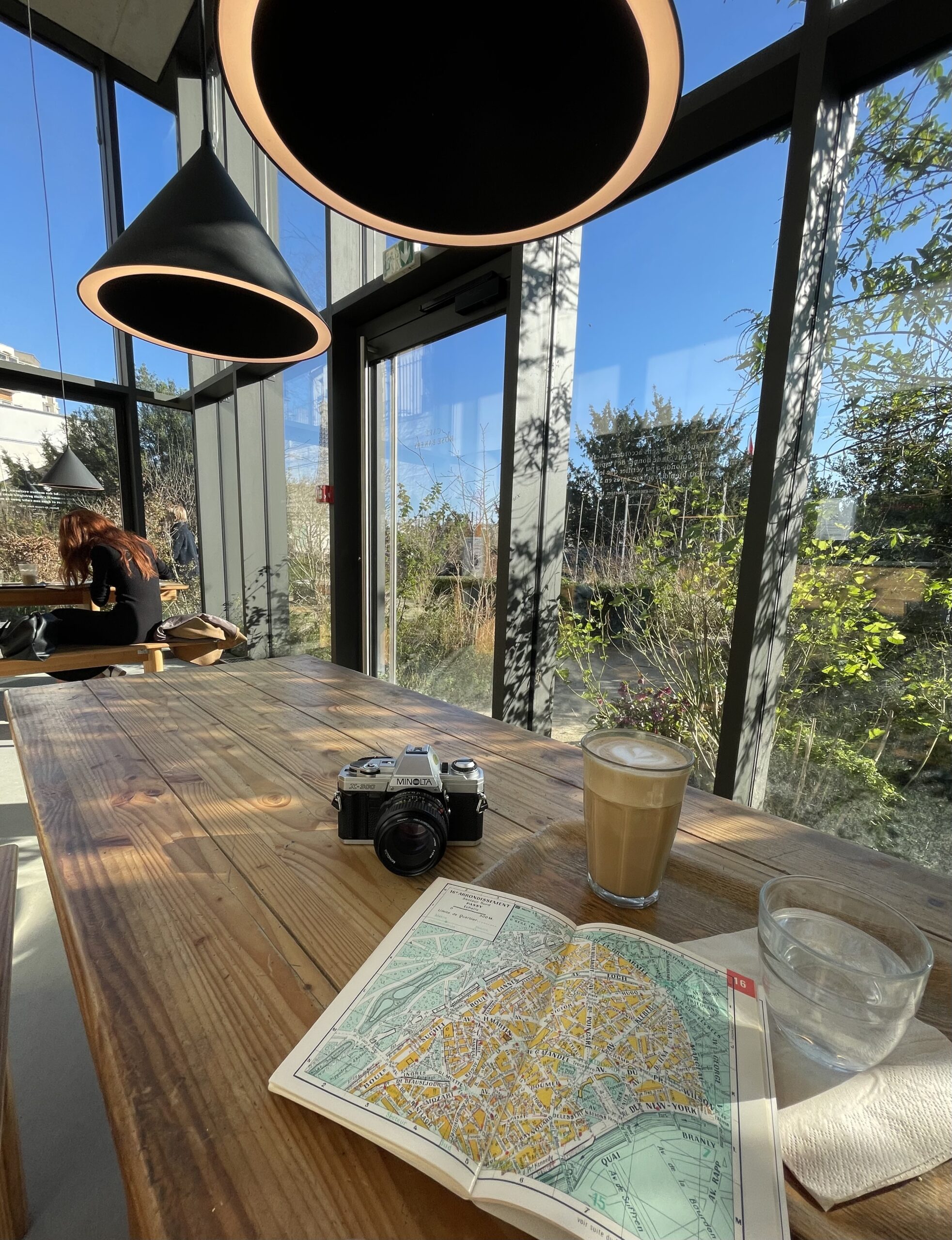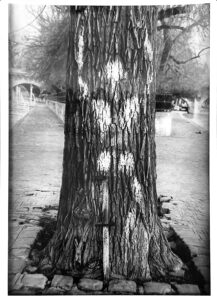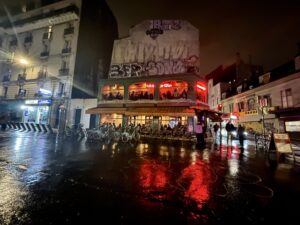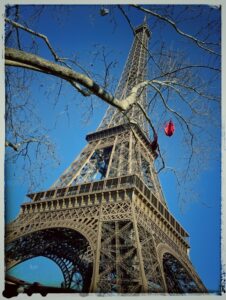Winter Light: photography in Paris

When a digital flyer for a ‘Winter Light’ photography course in Paris fluttered past my desk, I clicked on it straight away. What better way to add a touch of sparkle to January while touching up my photography skills?
The facilitator, or chief photo-f
I’ve always loved taking photographs and spent no little time in my youth dodging, burning and masking in darkrooms. As part of my French degree, I studied in Paris for a year and, during that time, my Minolta X-300 accompanied me everywhere.

Graffiti on a tree by the Seine, taken with my Minolta SLR when I lived in Paris
For this course, though, we were mainly focusing on our phone cameras. I took the Minolta with me so it could see Paris again, but ended up taking most of the shots using my iPhone. I love loading a camera with film, feeling the click of the shutter and the heft of the body, but I have to admit the iPhone is more portable and versatile.
Richard knows Paris extremely well and took us to areas I’d never explored before, such as the Port de l’Arsenal, a marina that links the end of the Canal St Martin to the Seine. During the two-day course, we dotted all over the city, from cafes and markets to canals and green spaces, interspersed with visits to photographic galleries.

A restaurant in Belleville casts red reflections on the rain-soaked road
Here are some of the lessons I learned.
Go for the shot
I’ve always been a bit nervous of taking photographs of people. Richard encouraged us to make shots happen. So I got chatting to people and asked if they were happy for me to take their picture.
At Cafe Charlot in the Marais, I was struck by the echoes between the red and white t-shirts worn by the waiters and the red and white design of the calendar. The waiter kindly posed for me with his tray, but I got a better shot when I stood on tiptoes to get a picture of the waiter with some croissants in the foreground.

Taken at Cafe Charlot in the Marais, Paris
Fired up by this experience, I also took photographs of an Argentinian actor in Belleville and a couple of builders in Oberkampf. In fact, the builders asked me to take their picture. I’d taken a shine to their dayglo wheelbarrow, asked to photograph that, then they asked me to take their photograph too.
Avoid reflections
Richard shared a great tip on how to avoid photographing reflections on glass when you’re taking a picture through a shop window, for example. Simply put the phone right up against the window, and the reflection disappears.
Embrace editing
“Editing’s as important for photography as it is for writing,” said Richard. He showed us some useful techniques to try and recommended a couple of apps, including Halide and Snapseed. Halide, a camera for iPhone and iPad, allows you to take high-definition shots and has an array of other features I have yet to fully explore. Snapseed has all kinds of cool editing tools to enhance images and add artistic effects. I like the different framing effects and the option to create a vintage-style photo.

My picture of the Eiffel Tower, with a vintage effect and frame by Snapseed
Explore memory in both directions
On the second day, Richard set us a challenge: to take a picture that evokes a memory. Intriguingly, it could either be a photograph that conjured up a memory from the past or one that would capture a memory for the future.
That afternoon, I was walking with Sue Evans, one of the other participants (and, coincidentally, another editor of Threads of Time, the book we put together to celebrate 25 years of the Fine Cell Work charity). We both had memories associated with the Place des Vosges. I took a short video of a yellow and white parasol at a bar I’d visited with friends, while Sue took this wonderful picture of the two of us, reflected in a window.

Capturing a memory in the Place des Vosges. Credit: Sue Evans
Follow your curiosity
There’s something extremely liberating in the idea of indulging your curiosity. That’s the genius behind the concept of the artist’s date in Julia Cameron’s The Artist’s Way. Another more recent discovery in the same vein are the Walkshops by Street Wisdom, where you take a question for a walk and let nature tell you the answer.
Richard encouraged us to follow our curiosity and see where it led us. One day, I started walking up a hill and just kept going, arriving at the Parc de Belleville, walking up a curved stairway to the top of the park and being rewarded with a view over the whole of Paris. Highly recommended, if you want a less crowded alternative to the view from Montmartre.

The sky is reflected in a pool at the top of the Parc de Belleville in Paris
Looking at the world with a fresh eye
I returned to London looking at everything with a fresh eye, with great memories and a host of new photographic techniques in my backpack. Maybe it’s time to get back in the darkroom.
More
- Read about the mystery of Balzac and the magic ants
- Discover how Jacques Tati tells a story through sound
- Take a trip to Bordeaux’s futuristic wine museum